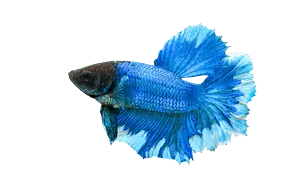Nerite snails are popular among aquarists because they are one of the best algae eaters in a fish tank.
These snails also have a docile nature, which makes them an excellent choice for a community tank.
The only downside of nerite snails? They are prolific egg layers. More specifically, female nerite snails lay capsules containing 30-100 eggs!
We need to remove Nerite snail eggs quite often from their tanks.
To remove Nerite snail eggs before they become a problem, scrape them off the sides of your tank using an algae scraper or bladed scraper of some kind. Take care not to scrape so hard that you accidentally damage the tank sides or injure your snails.
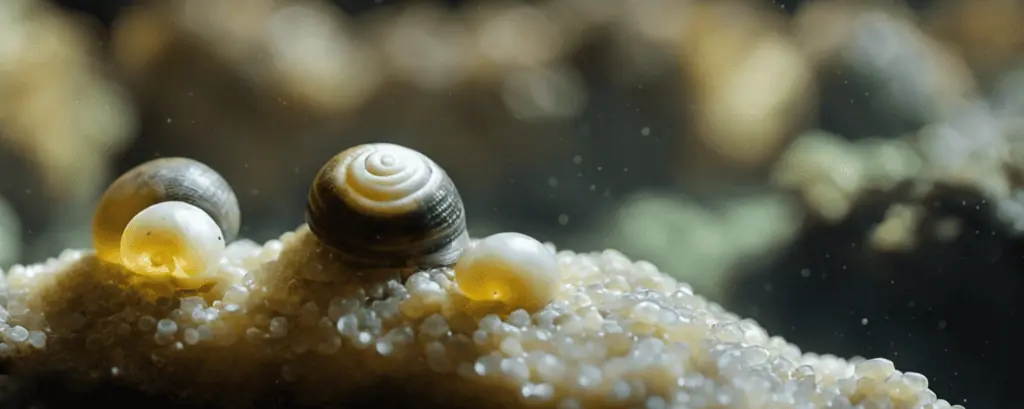
Table of Contents
What Do Nerite Snail Eggs Look Like?

Nerite snail eggs appear as small white ovals throughout your aquarium. These white ovals are not actual snail eggs, though.
What you see are small capsules containing between 30-100 microscopic snail eggs.
These capsules resemble white sesame seeds in size and shape. They have a hard outer shell to protect the tiny eggs inside.
Nerite snail eggs are bright white and show up well on dark surfaces.
Female nerite snails lay their eggs almost anywhere in the tank.
You may find nerite snail eggs in several places, such as:
- Driftwood
- Rocks
- Under plant leaves
- The sides of your tank
- Substrate
- Filter media
- Caves
Any hard surface in your aquarium can potentially contain nerite snail eggs.
If you have a freshwater tank, you do not have to worry about a huge increase in your nerite snail population.
The successful hatching of nerite snail eggs is only possible in brackish water.
Very rarely, nerite snail eggs hatch in a freshwater aquarium. When a small population of snail babies does hatch, they do not survive for long in freshwater conditions.
3 Reasons Why Nerite Snail Eggs Are Harmful to Your Aquarium

The presence of nerite snail eggs puts your entire aquarium in danger.
Nerite snail eggs are harmless on their own. But having too many of them in your tank causes bad side effects.
Female nerite snails lay eggs all year. Before you know it, your tank may become overloaded with nerite snail eggs.
1. They Impact Your Water Quality
Unhatched nerite snail eggs dissolve after some time in freshwater.
The waste produced by the dissolving eggs increases bacteria in the water and may cause ammonia and nitrite spikes.
Nerite snail eggs also give your aquarium a messy appearance with little white dots all over the place.
If nerite snail eggs clog your water filter, bacteria and toxins are not removed from the water. This causes poor water quality.
2. They Affect Other Aquatic Wildlife in Your Aquarium

When nerite snail eggs lower your water quality, this affects the aquatic wildlife in your aquarium.
Poor water quality makes your fish prone to diseases and parasites.
Aquarium plants are usually not bothered by the nerite snail eggs, but changes in water quality may affect growth.
3. They Cause Potential Harm to Adult Nerite Snails

Sometimes, nerite snail eggs end up on the shells of other adult nerite snails. This is usually not a problem.
But if there are a lot of eggs on the snail’s shell, it may cause issues with shell growth.
Poor water quality resulting from too many snail eggs could make your nerite snails sick. It also increases breeding behavior among nerite snails, leading to even more eggs.
3 Ways To Prevent Nerite Snails From Laying Eggs
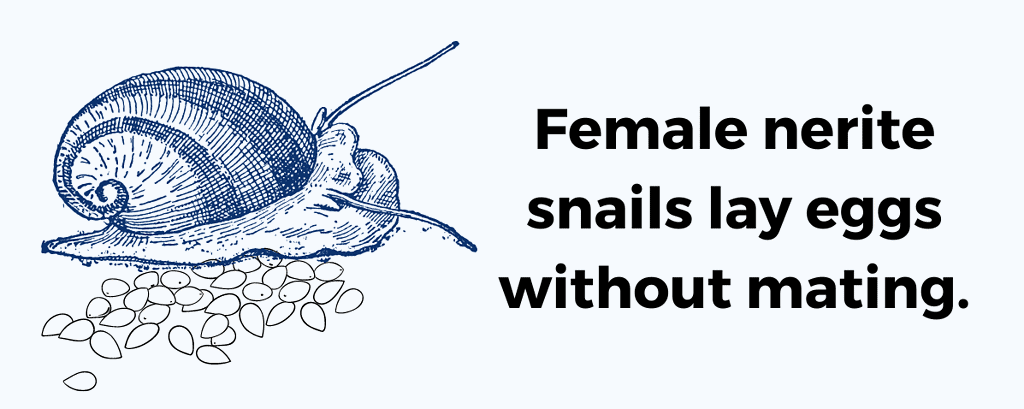
There are several ways you may discourage your nerite snails from breeding or laying eggs.
Some methods work better than others. Not all prevention methods are safe for other fish in the aquarium.
You may successfully prevent breeding among your nerite snails. But, female nerite snails still lay eggs even without mating.
1. Keep the Tank Clean
Keeping your tank clean may seem like common sense. Dirty aquarium water causes unwanted bacteria and toxin buildup.
Generally, clean aquarium water keeps your fish healthy and thriving.
Nerite snails are the exception to this rule.
They are sensitive to ammonia and nitrites, just like any other aquatic creature. But, a dirty tank usually contains loads of algae and other waste products like leftover food.
Nerite snails thrive on algae, so a dirty tank is like a buffet. When nerite snails are well-fed, they are more likely to reproduce.
Keeping the tank clean prevents nerite snails from overeating and may slow their breeding habits.
But no algae means less food for your snails. If there is no algae buildup in your tank, you must feed your nerite snails algae wafers.
Remove leftover wafers from the tank within a few hours of feeding your snails.
When algae wafers dissolve, they make the water cloudy. They also boost nitrites and nitrates in the tank.
Blanched vegetables like carrots and cucumbers are also good for a nerite snail diet.
Perform partial water changes once per week. Remove 20% of the tank water and replace it with dechlorinated water.
2. Lower the Tank Temperature

When the water temperature increases in the aquarium, nerite snail reproduction also increases.
Lowering the temperature discourages breeding behavior in nerite snails.
This method could be dangerous for your nerite snail tank mates. You must take care not to lower tank temperatures too much.
Tropical fish like bettas need warmer temperatures. In temperatures below 75° degrees Fahrenheit (24° C), your betta may suffer from digestive issues and other illnesses.
Nerite snails thrive in temperatures between 72-78° degrees Fahrenheit (26° C). If there are no nerite snail tank mates, you may keep tank temperatures at the lower end of this range.
This method is not guaranteed to reduce nerite snail eggs in the tank.
Female nerite snails lay eggs without mating and may keep laying eggs in lower temperatures.
3. Separate the Females From the Males

Separating female snails from males is the only guaranteed method for preventing snail eggs in your tank.
Many other types of freshwater aquarium snails reproduce asexually. This means a snail may fertilize its eggs without a mate.
Nerite snails only reproduce when a male and female mate.
Separating the female snails from the males is a challenge. There is no distinct difference between males and females.
The only way of knowing which nerite snails are female is by placing them in smaller individual tanks. If the snail lays eggs, you have a female.
Once you determine the sex of your nerite snails, add the males back to the main tank.
You may consider keeping the female nerite snails in their own tank and letting them live out their lives.
Why Avoid Using Aquarium Salt With Nerite Snails?
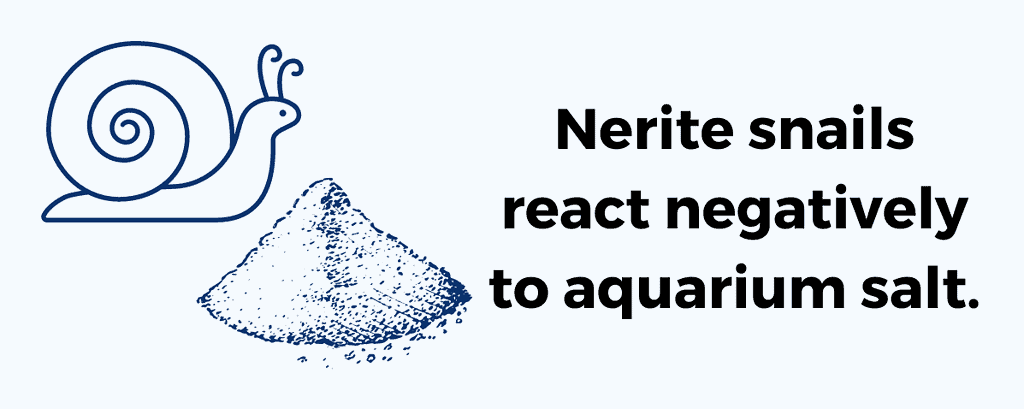
Aquarium salt is a remedy for several ailments in fish.
Avoid adding aquarium salt to the water if you have nerite snails in a community tank.
The aquarium salt could make the water brackish enough for the successful hatching of nerite snail eggs.
This creates a serious problem if you have loads of nerite snail eggs in your tank.
Instead, place your fish in a separate quarantine tank for administering aquarium salt or other medications.
How To Safely Remove Nerite Snail Eggs From Your Aquarium

Removing nerite snail eggs from your aquarium is a challenging and time-consuming task.
With the right tools, removing the eggs of nerite snails is much easier. It still takes effort, but physical removal is the most effective method.
Avoid using iron tools in your aquarium. Water oxidizes iron and leaves stains in your fish tank.
Use only stainless steel tools, which do not oxidize.
Tools You Need for Nerite Snail Egg Removal
You only need a few tools for removing nerite snail eggs:
- Stainless steel spoon, razor blade, or sharp algae scraper
- Soft toothbrush
- Cotton swab
- Gravel vacuum
Gather your tools before you begin the process of nail egg removal.
The Process for Removing Nerite Snail Eggs
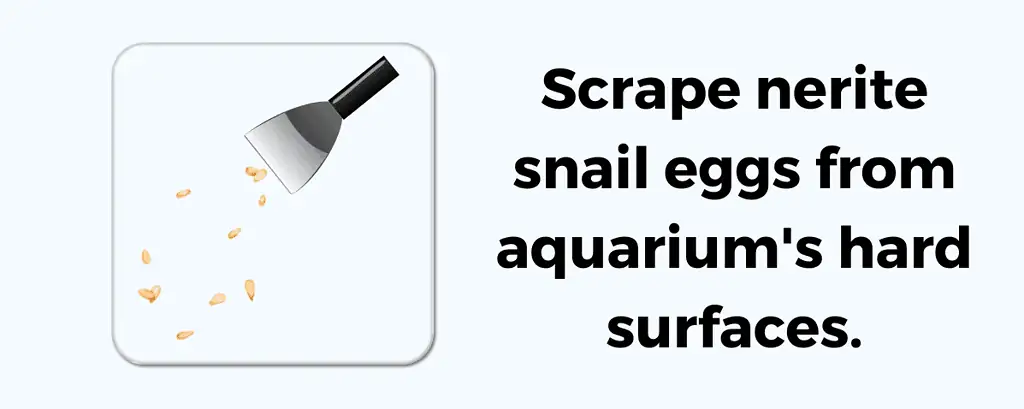
Begin by scraping the nerite snail eggs from hard surfaces in your aquarium. These include the glass sides, rocks, and other decorations.
Use a stainless steel spoon or razor blade to scrape the white bumps off of surfaces. A sharp algae scraper also gets the job done.
Removing nerite snail eggs from driftwood is more challenging. No matter how careful you are, outer layers of wood may come off.
Nerite snail eggs also leave behind white oval traces on driftwood.
Consider using a soft toothbrush on delicate surfaces like driftwood or aquatic plants.
Use a soft toothbrush or cotton swab to remove snail eggs from a snail’s shell. Use a light touch to avoid damaging the snail’s shell.
Look in small cracks and crevices in the tank to ensure complete nerite snail egg removal.
After scraping the snail eggs off surfaces, they fall to the substrate. Use a gravel vacuum to remove the fallen eggs.
Never Use Chemicals for Nerite Snail Egg Removal

If you search the internet for nerite snail egg removal methods, you may find bad aquarium advice.
Many of these methods involve taking drastic steps for snail egg removal using chemicals.
Avoid using substances like metaldehyde or a copper sulfate solution.
Metaldehyde is a common pesticide used for the removal of slugs and snails. It not only gets rid of snail eggs but kills the snails as well.
Copper strips and copper sulfate solutions also kill nerite snails. Even fish-safe doses of copper sulfate solutions are harmful.
The copper sulfate solution may damage fragile aquarium plants and harm other tank mates. Any amount of copper is deadly for shrimp and causes illness in sensitive fish.
Do not use cleaning solutions like bleach in your fish tank. The chemical residue is difficult to completely rinse away.
Any fish placed in the tank after chemical cleaning may become very sick.
Stick to physical methods of removing nerite snail eggs from your aquarium.
Will Fish Eat Nerite Snail Eggs?
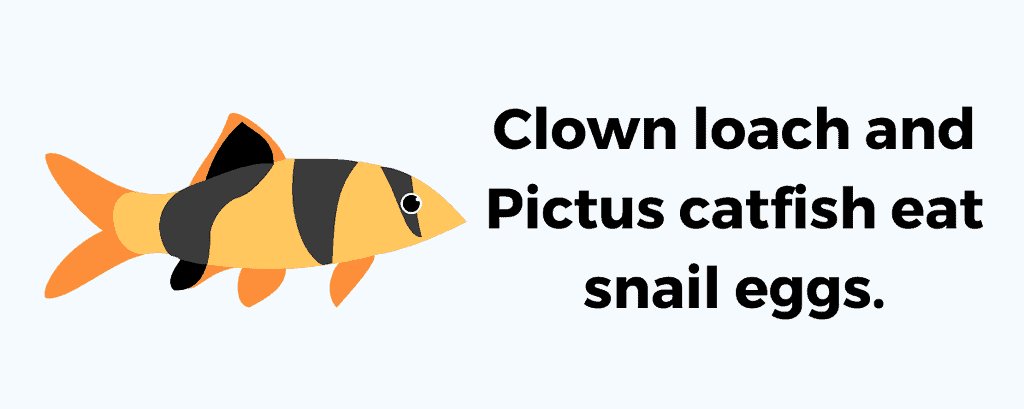
Some species of fish eat snail eggs, such as:
- Clown loach
- Pictus catfish
- Dwarf chain loach
- Zebrafish
- Amano shrimp
But some of these aquatic creatures may have difficulty prying nerite snail eggs from surfaces.
If you have a hard time removing nerite snail eggs with a razor blade, a fish will not have any luck either.
Some of these species are also carnivorous fish. They will not only eat the snail eggs but the adult nerite snails as well.
Employing snail-eating fish is a drastic step. Only add them if you have a large tank and want complete elimination of your nerite snails.
Frequently Asked Questions About Nerite Snail Eggs

How often do nerite snails lay eggs and how many at a time?
Nerite snails vary in how often they lay eggs. On average, they lay eggs every 1-3 days. There are also periods when nerite snails do not lay eggs at all.
It is unclear how many eggs a nerite snail lays at one time. Each nerite snail capsule may contain anywhere from 30-100 eggs.
Can I hatch the eggs and raise the baby snails?
Hatching and raising baby nerite snails is possible in the right conditions.
First, you need a separate tank for breeding. A 10-gallon tank provides enough space for the nerite snail eggs. Create brackish water with marine salt. The ideal salinity level ranges from 1.005-1.010.
Install an aquarium heater to maintain warm temperatures. Use calcium sand for substrate and provide a few plants for a more comfortable environment.
After mating, place the female in the breeding tank until she lays her eggs. When the eggs hatch, feed them with spirulina powder every day. Nerite snails reach maturity at six months of age.
Do not get discouraged if your nerite snail eggs do not hatch. Breeding nerite snails is complicated because they are very sensitive to their environment.
Will removing the eggs harm the adult nerite snails?
Removing the nerite snail eggs from the tank does not cause harm to adult snails. Female nerite snails continue laying eggs, and likely won’t notice if some disappear.
Can I leave the eggs in the tank and will they hatch?
Leaving the nerite snail eggs in the tank is possible if they do not affect your water parameters. But, if you have your nerite snails in a freshwater tank, the eggs will not hatch.
Successful nerite snail egg hatching requires brackish water. Nerite snail eggs occasionally hatch in freshwater, but the babies rarely live to adulthood.
Don’t Be Slow To Remove Nerite Snail Eggs
Nerite snail eggs are not usually a problem for your tank unless there is a high number of them.
When the eggs start affecting your water parameters, removal is necessary.
The nerite snail eggs do not usually hatch in freshwater, so there is no worry of a population explosion.
You may create a brackish tank for breeding nerite snail eggs apart from your main tank.
Learn more about nerite snails with our complete guide on nerite snail care.

